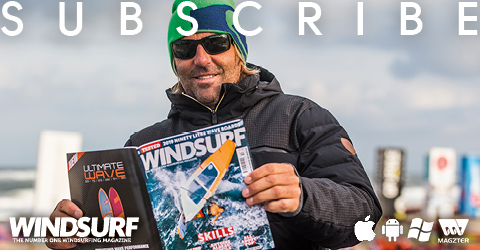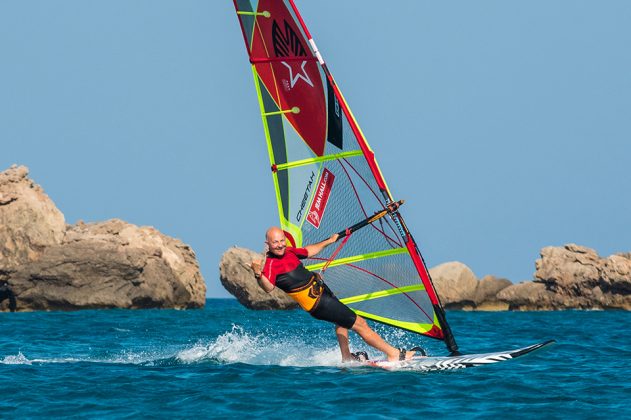JEM HALL
MOVE ON UP – WINDSURFING TECHNIQUE
ENHANCE YOUR STANCE
People come on my coaching clinics to nail targets like better gybes, tacking and jumping, wave ride smoothly or even learn to loop, but the main skills they learn on their first few trips are from my oft quoted ‘Trinity’ of skills – planing early, sailing fast and getting upwind. This month I will look at the top tips to improve these areas, with the aim of producing a better stance that is both effective and efficient. A good stance ensures you enjoy your ‘Effective time on the water’ more and are in the best position to improve in a huge range of moves, so let’s get started on enhancing your stance!
Words Jem Hall // Photos Nicolas Jones
www.jemhall.com
(This feature originally appeared in the October 2018 issue of Windsurf Magazine. To read more features like this first, Print and Digital subscriptions are available. Prices include delivery globally for 10 x issues a year!)
PLANE EARLIER
This is a hugely important skill in the ‘Trinity’ as it extends your wind range massively, i.e. the amount of time you can stay on a given board / sail size. If you plane earlier then you have more chances to get up to speed and get upwind, do all these and you’re winning at windsurfing!
PLANING – 3 WAYS
Before we kick off with the tips on early planing I will recap on the 3 different methods we can use to get into the straps / get planing. It is of utmost importance to get very good at all 3 so you can choose the most suitable one given a certain set of conditions. For example, in Moulay on my wave clinics I was reminded again how much my clients had to be able to get in the straps early, even before they were planing!
1 – Traditional: get hooked in and then into the straps. This is perhaps the easiest technique for lower ability sailors or more moderate winds.
2 – Active: from a dynamic low position get the board planing unhooked, then get in the straps and then hook in. This pays huge dividends for the
future and will boost your fitness and ability to get planing gybes and
improve quickly at wavesailing.
3 – New School: from a non-planing position get into the straps smoothly and then look to bear away and plane on a gust either before or after hooking in. Modern boards and wave boards prefer this as you can be more active and use your legs more to steer, unstick and almost lift the board onto the plane.
ADD SOME T’S
Before you start planing please realise there are 2 areas where you can begin planing. One is on the water of course, but the less obvious one is on land by adding the ‘T’s’ below to your approach before you hit the water.
• Temperament – you actually believe you will get planing!
• Tuning –set up your kit suitably. Be the pilot and not the passenger!
• Timing – choosing when to get planing in the most suitable area of the water (e.g. enough flat water between waves) and in the right amount of wind, often after you have spotted a gust.
TOP PLANING TIPS
Here are the most essential tips for planing early and getting in the straps:
• Look upwind to spot gusts to utilize and chug upwind by sinking the rail to gain ground when not planing. (Timing).
• Your starting stance is back foot placed behind the front straps and facing across the board. The front foot faces forward and is towards the mast foot.
• Really pull down on the boom and get your weight on the rig. It’s crucial to do this when moving into either strap!
• Keep your back leg bent when getting into the front strap.
• Get the rig forward and away on extended arms, shoulder width apart hands, to ensure it is upright and catching the most wind.
• Place your front hand very proximal to your front harness line to illicit max power from the sail.
• Keep the board flat by mainly bending your back leg and pushing the board forward through the front foot and leg.
• Bear away (turn downwind) by scissoring your legs, push through the front foot and pull the tail upwind with your back leg. (Timing and Temperament).
• When looking to get the relevant foot in the strap ensure the weight is on the other foot and the mast foot through downforce.
• Feel the sail’s power and work with it to ensure you do not oversheet.
All of the above can make huge differences to your early planing. Try 1 – 2 of these tips in a 20-minute power session.
PLANING KILLERS
Do not underestimate the ability of people to not plane when the wind is suitable. This is why it is hard to recommend a sail size, as body weight is only one part of the story, technique and skills play a much bigger part. I know heavyweights who plane extremely early and lightweights who need way too much wind to fly.
The following actions will hinder your planing ability:
1. Gear gazing: you will miss gusts and not read the water state.
2. Rig hugging / boom licking: the rig will not give you all the power that it can and in turn this will sink the tail.
3. Holding the line: if you do not bear away, and by the right amount, the board simply cannot plane. Instead choose these lines – turn downwind to get momentum, accelerate across the wind, go upwind when lifting of the fin or fins starts.
4. Oversheeting: you turn downwind and just as you accelerate you give a massive heave in on the back hand. Having your back hand too far back exacerbates this.
“ Practice sailing one handed to bring out many of the skills you need. ”
This is a ‘real world’ sequence of getting planing in gusty winds on flat water and with a 5.8 on a 110 freemove board.
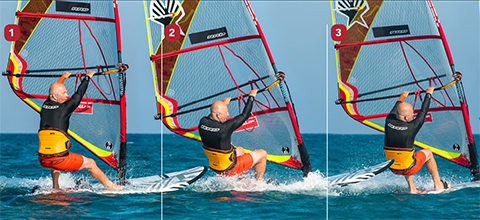
1. From a classic hang like a monkey pose look upwind to spot a gust with the rig forward and upright, hands together and back leg bent. You are then able to drop and push the board downwind to get momentum.
2. As you get some speed pull down hard on the boom, and maintain the bent back leg, to free up your front foot and place it in the front strap.
3. Here you might feel that there is not quite enough power, so keep the front arm straight as you push through the toes of the back foot and pull with the ball of the back foot.
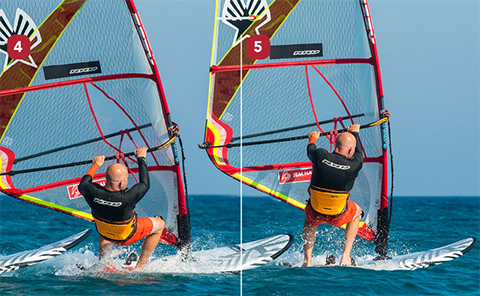
4.As you hook in you will have to bend your arms and raise your hips, both of which can upset the sail and board trim. Ensure you have an efficient hooking in and out technique!
5. Once you are in the lines, and likely to have lost a bit of power, you should again ensure your rig is forward and upright to give you power. Once the fin starts lifting enough you can then get down and out as you look to straighten your front leg.
SAIL FAST
Sailing fast is not flying around out of control, rather it is getting the fin/s lifting, the sail light and primarily being in control and looking to enjoy the conditions on offer and being in a position to improve. This ‘comfy’ speed also means we have a bigger choice of sailing lines, so we can either head up or downwind to a greater extent, and this will open up more opportunities for moves and getting through ‘bumpier’ water efficiently.
General guidelines
• Keep the rig away and the board flat with the sail relatively still.
• An easy way to sail fast in all planing winds is to ensure your head is at boom height and allow your hips to move to balance the sail’s power.
• Go upwind when looking to get control and turn downwind to keep speed in lulls. A lot of people are fast in gusts but really drop speed in lulls.
• Aim to have a great wind range and high average speed.
• Read the water and flex your knees accordingly in order to stop the nose lifting and concomitantly the fin losing grip.
• Practice sailing one handed to bring out many of the skills you need.
Underpowered
If you find yourself underpowered, here are some tips to keep your speed up:
1. Anticipate a drop in the wind by always looking forwards AND upwind. (Look).
2. Ensure your hands are together to get the rig upright and to stop you oversheeting as your sail power drops. (Feel).
3. Tighten your torso / core. (Lock).
4. As your fin pressure will have dropped, push down through your toes and lift your hips to stop the rail sinking. (Lock and lift).
5. In long and light lulls you can angle / tilt your upper torso forward to pull down more on the mastfoot thereby maintaining a flat board when the tail wants to sink. This shifts you forwards and out on to the front foot! (Keep out).
6. Experiment with your sailing line to discover how much you can and should turn downwind in order to keep speed. (Line).
7. If you bear away just before you lose power this can give you some vital speed to keep the fin lifting and help you keep momentum until the next gust. (Line).
8. Experiment with taking the back foot out of the strap and placing it in front of the back strap, to keep the board flat. (Flat board).
9. Lastly, be subtle and smooth.
Well powered
If you’re well powered than these are the main tips for maintaining speed:
1. ‘Get down James Brown!’ Your body and rear hip must get out (boards), back (towards the tail) and down (towards the water). (Stay low).
2. Spread your hands to give you more leverage to create downforce and the ability to trim quickly. (Pull down).
3. Drop the elbows and pull down hard on the boom. (Drop).
4. Drop your heels by lifting your toes and get leverage by being outboard. (Get out and get down).
5. Be fit. Your leg strength (endurance), core and triceps will be working to the max.
6. Lock down the rail by getting outboard. (Get out).
7. Choose your line: upwind to give you more control, and a rest, and then downwind to lighten the sail when you are able to. (Line).
8. Feather the sail. It is possible to ‘throttle off’ on the back hand and compensate for the loss in downforce by shifting out and forward to weight the mastfoot and flatten the board. (Trim).
9. Flex the back leg a lot! This stops the nose flying up. (Flex).
10. Lastly, focus and commit. Sailing fast when fully powered requires concentration!
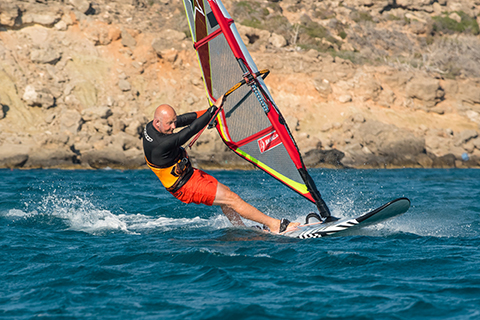
Accelerate by leaning forwards and out, angling your torso as you push down through the front foot.
Conditions
Go to the right spot to get the right conditions.
Work with the conditions and even if the wind drops or picks up, stay out to learn more.
Seek out conditions that will challenge your wind range, for example, lighter airs or windier than you would normally like.
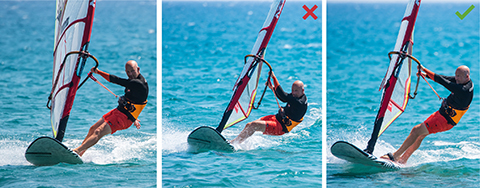
Dropping the back hand will help you appreciate how the hips sheet the sail in and how much your front arm pulls down on the boom.
Hitting a lull, or perhaps losing focus, sees me lose power and so I’m pulling in on the boom (bad) and sinking the rail (bad). I need to get power back in the sail and accelerate.
To compensate I have scissored the kit downwind, extended my front arm, moved my hips up and then pushed down through the front foot.
GET UPWIND
If we’re not upwind, then we can’t, and perhaps wont, take advantage of gusts in order to bear away and get planing. Therefore this ‘Trinity’ skill really is the most important! So your philosophy has to be ‘get your money in the upwind bank by sailing upwind’, either as soon as you have the speed to get the fin/s lifting enough or through ‘chugging’ upwind should planing not be possible. The latter is where we use the rail as a daggerboard to give us grip to cruise upwind slowly.
Chug it
Let’s look at, ‘chugging’, upwind non-planing first. Unless it is very windy, do this as soon as you get going, either from a start or a turn. A positive of doing this is that you can see the wind so you can use your ‘timing’ more
effectively. Also as you are gaining ground upwind you will be well positioned to turn downwind to plane and with more confidence too. This will aid all levels of rider and get you upwind to help learning to use the footstraps, and it will aid catching waves for riding and many more moves. Here are some tips:
• Where you look is where you go. This is the best tip of all, so look upwind and ensure the front foot faces forward!
• Step forward and out, in order to sink the rail. Think ‘rail, not sail’ to get upwind. Find the sweet spot on your board for this.
• Keep the sail relatively open, leech flapping and upright (arms bent) as you are not using sail power, but using rail power (purchase).
Fly upwind
Your major target when planing is to use your speed to get enough fin lift so you can push the board upwind. Now if you think you’re sailing upwind enough, try and point higher! This will boost your upwind skills hugely. Aim to point as high as possible, especially when well powered, or in gusts.
Main upwind sailing tips
• Only when sailing fast enough should you sail upwind as only then will the fin be creating enough lift to allow you too. (Speed).
• Look upwind and bring the rig back as your body moves forward, which allows you to push / resist through the back leg. (Rig back / Body forward). • Keep your body low and outboards with your front shoulder dropped. (Look).
• Rig is kept away and sail oversheeting is avoided by placing your hands close together. (Feel).
• The more the rig goes back and your body forward, the more you can push through the fin to squeeze upwind higher. (Push it).
• A great tip for flying upwind – and introducing more feel to this skill – is to sail one-handed. (Let go and Feel).
• Dropping the front hand opens up your shoulders, brings your hips forward and out, whilst keeping the rig back and away. (Rig back/Body forward).
• The more you look upwind, the higher you will go (point) and, whilst looking in this direction, we also look at the wind to examine what sailing line to take. (Look).
• Head upwind (point higher) in the gusts and bear away (turn downwind) in lulls. These subtle changes in direction will really help you keep your speed. (Line).
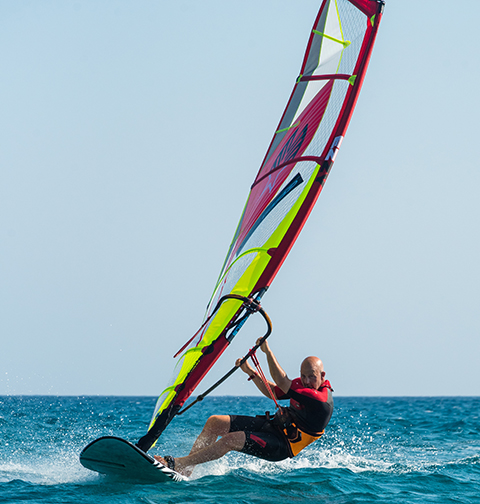
Well powered sailing requires you to pull down on the boom, drop elbows, get lower to straighten your front leg and pin the board down as you flex the back leg.
Kit
Generous straps allow feet in easily which smoothens early planing and helps to keep board flat.
Long lines, suitably placed, get you planing earlier and give you more top end control.
If underpowered consider moving boom up and reducing outhaul.
If overpowered consider dropping boom down, increasing outhaul, and moving mast base forward 1-2 cm.
Only do one tuning action at a time, then reflect.
Consider sizing up / down your fin/s.
RRD boards, wetsuits & softwear, Ezzy Sails & Black Project fins sponsor Jem Hall. Get him live and direct on one of his highly acclaimed coaching holidays but be quick as they are selling out – check out his fab new site www.jemhall.com for details. You can also follow him on twitter / Facebook / Instagram.
www.jemhall.com
